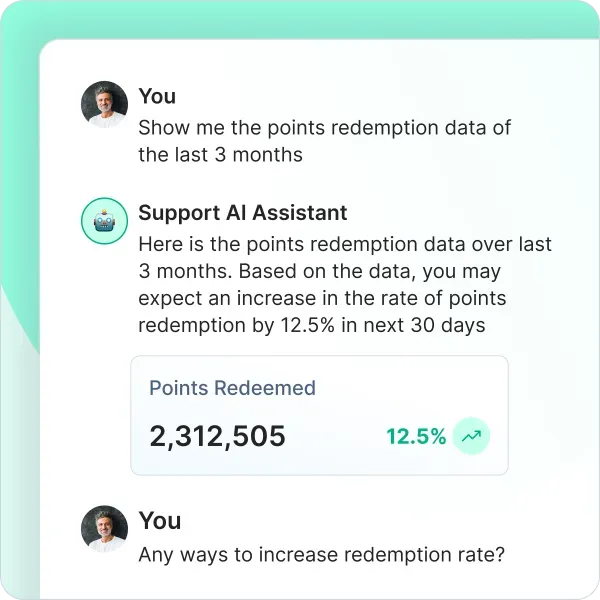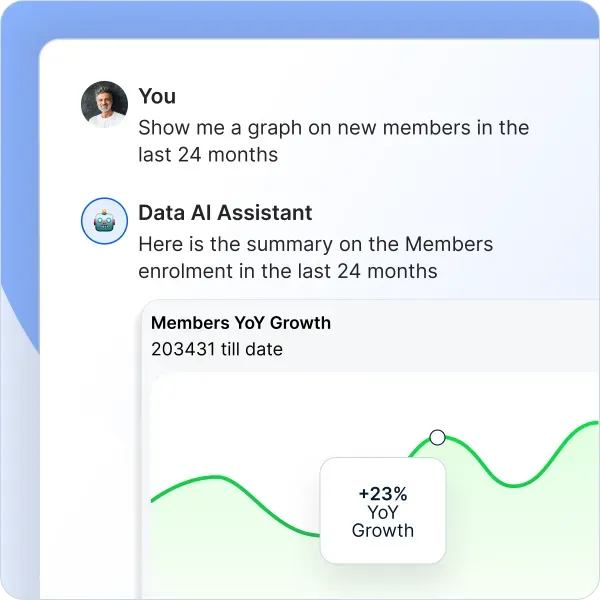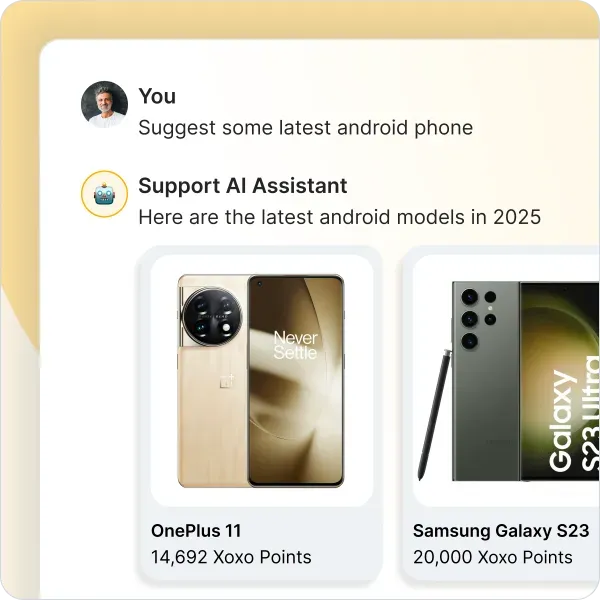How to Leverage AI to Build Customer Loyalty and Turn Buyers Into Brand Advocates
AI is redefining customer loyalty by turning passive buyers into brand advocates. From predicting churn to delivering personalized experiences and smart support, learn how AI can help you build deeper customer relationships that drive long-term business growth.
Di halaman ini
- The pitfalls of the traditional approach to customer retention
- How AI turns this challenge into an opportunity
- How to include AI for customer loyalty?
- Redefining the shopping journey with AI
- Real-world applications of AI in customer retention
- Transform loyalty with the power of AI-personalized engagement
- Pertanyaan Umum
AI, atau Kecerdasan Buatan, mengacu pada penggunaan teknologi canggih untuk mensimulasikan kecerdasan manusia dalam mesin.
Dalam konteks layanan pelanggan, AI dapat digunakan untuk mengotomatisasi dan meningkatkan berbagai aspek perjalanan pelanggan.
-AI-powered chatbots can provide efficient and consistent responses, improving response time and customer satisfaction.
-AI algorithms can analyze customer preferences and behaviors to deliver personalized recommendations, making interactions more engaging and relevant.
-AI enables real-time customer support and updates, ensuring that customers receive timely assistance.
-Generative AI can optimize your content.
Dengan AI di ujung jari Anda, Anda dapat meningkatkan pengalaman pelanggan, mempertahankan pelanggan setia, dan mengubah mereka menjadi pendukung yang bersemangat.
Jika Anda penasaran dengan kekuatan AI dalam membentuk kembali perjalanan pembeli, mempersonalisasi rekomendasi, dan mengoptimalkan konten, teruslah membaca.
The pitfalls of the traditional approach to customer retention
Traditionally, businesses have concentrated on obvious indicators of customer churn—like cancellation requests, missed payments, or subscription lapses. While these signals are easy to track, they often appear too late in the churn journey. By the time a customer cancels, dissatisfaction has already accumulated over time.
This reactive model focuses only on surface-level symptoms and overlooks the earlier, less visible signals that typically precede a customer’s departure. These can include:
• Mentions of competitor offerings
• Complaints about service quality
• Questions around contract commitments
• Decreased product usage
• Repeated service requests for unresolved issues
Relying solely on these final-stage triggers limits the opportunity to intervene meaningfully. Once a customer voices intent to leave, it’s often too late to change their mind. An effective retention strategy requires identifying and addressing these early warning signs—before dissatisfaction grows into a decision to leave.
How AI turns this challenge into an opportunity
Although customer churn is a persistent challenge, effectively addressing it can unlock significant growth and enhance retention for subscription-based businesses. Here's how AI can turn this obstacle into a strategic advantage:
1. Take a life-cycle-based approach
Conventional retention strategies often focus on end-of-term cancellations or clear signs of dissatisfaction, missing early opportunities to intervene. This allows negative experiences to build up, leading to eventual churn.
AI changes the game by tracking customer interactions and behavior throughout the journey. It detects subtle churn signals—beyond the obvious—by analyzing usage, sentiment, and engagement patterns. This lets businesses proactively address concerns and enhance the experience before dissatisfaction grows. By anticipating risk across the customer life cycle, AI enables more effective churn reduction.
2. Assign a risk score to every customer
Every customer follows a unique journey, so the risks and triggers for churn differ. Knowing how many might cancel isn’t enough; businesses need to understand which customers are most likely to leave and why.
AI enables this by using behavioral data, sentiment analysis, and machine learning to assess individual churn risk. A key feature is predictive risk scoring, similar to FICO scores, that compiles multiple attributes into a profile showing both the likelihood of churn and its causes.
Beyond churn prediction, AI also forecasts metrics like NPS, retention, upsell potential, pricing sensitivity, referrals, and win-back likelihood, unlocking broader revenue opportunities across the customer base.
3. Extend personalized retention offers
Not every customer responds to the same retention strategy, and generic offers can be inefficient or even counterproductive. AI addresses this by tailoring engagement based on individual needs and behavior.
By combining predictive insights with customer-specific motivations, AI enables businesses to create highly personalized retention offers, through exclusive incentives, adjusted service levels, or contextual messaging. These targeted solutions are far more effective in preventing churn, especially when delivered early.
Organizations using AI-driven personalization have seen significant improvements in retention, with some achieving up to a 400 basis point lift. This not only preserves customer value but also strengthens long-term loyalty and competitive advantage.
How to include AI for customer loyalty?
Transforming loyal customers into passionate brand advocates requires more than just good service, it demands meaningful, personalized engagement. AI empowers businesses to do just that by using data-driven insights to craft tailored experiences, anticipate customer needs, and foster deeper emotional connections.
Here’s how AI can drive satisfaction, build loyalty, and ultimately inspire advocacy at scale:
1. Personalizing customer experience through AI
AI enhances personalization in marketing by using machine learning and NLP to analyze customer behavior, preferences, and interests. This helps businesses develop strategies that build stronger, more authentic relationships.
With AI, companies can deliver personalized product recommendations, offers, and experiences based on customer interactions and purchase history. For example, visitors to an e-commerce site may receive suggestions tailored to past purchases, while banking apps may offer refinance deals based on content engagement.
AI also powers customized loyalty programs. Frequent shoe buyers might receive targeted discounts, while others get offers aligned with their preferences. Spotify Wrapped is a great example, summarizing users’ top music choices using listening data.
Incorporating this level of intelligent personalization into your 2024 marketing can boost engagement and retention. By analyzing data like browsing patterns and purchase history, AI helps customers feel seen and valued—key to building long-term loyalty.
2. Integrate chatbots into your sales channels
Customer experience refers to how customers perceive your brand throughout their buying journey. Factors like ease of issue resolution and smooth navigation between channels influence these impressions.
AI enhances customer experience by streamlining touchpoints, especially in service and support, enabling quick issue resolution and seamless transitions across websites and social media. A key example is chatbots.
Chatbots use conversational AI to automate responses, helping customers access information easily without manual research or human support. They offer 24/7 assistance, answering common questions anytime.
While early chatbots relied on predefined prompts, modern versions use natural language understanding (NLU) to interpret and respond to open-ended questions. These context-aware bots can hold real conversations based on user input.
For example, a chatbot on a travel agency website can ask visitors about their preferences and suggest personalized travel options based on their answers.
As chatbot capabilities expand, developers integrate machine and deep learning to improve their comprehension and response quality. These advanced tools offer reliable support and help drive customer retention and loyalty.
3. Predictive analytics: A key AI tool for reducing customer churn
Predictive analytics is an AI application that uses machine learning and statistical algorithms to forecast outcomes based on historical data. In marketing, it leverages customer data to anticipate future interests, preferences, and behaviors.
By processing behavioral and transactional data like account activity, purchase history, and online engagement, AI can identify customers at risk of leaving.
For instance, a financial institution might detect dormant accounts and offer targeted incentives to re-engage those users. This proactive approach reduces churn and strengthens long-term relationships.
Implementing predictive analytics in your acquisition strategies offers these benefits:
- It analyzes large-scale consumer demographics, allowing you to categorize potential customers and create hyper-targeted ad campaigns.
- It identifies new market segments with growth potential, helping you expand your reach and customer base.
- It reviews past service outages and incidents over 12 to 24 months, revealing recurring issues that you can address to improve reliability.
- It enhances sentiment analysis by detecting positive, negative, or neutral tones in feedback, helping refine marketing and boost satisfaction.
- It calculates customer lifetime value (CLV) to pinpoint high-value customers, guiding resource allocation to improve retention and profitability.
- It maps out the ideal customer journey by analyzing historical behavior and predicting how new users might interact with your offerings.
- It predicts churn, helping you identify customers likely to leave so you can take timely action to retain them and reduce attrition.
4. Automating customer service with AI
AI technology plays a critical role in automating customer service functions, such as answering routine inquiries, resolving basic issues, and delivering real-time support.
This automation improves response time and efficiency, allowing human agents to focus on resolving more complex or sensitive concerns.
The outcome is twofold: customers receive faster, more reliable service, while businesses benefit from streamlined operations and resource optimization.
5. Image recognition technology: Enhancing visual content with AI
AI-powered image recognition technology enables businesses to analyze and understand which visual elements resonate most with their target audience. By processing large volumes of image data from social media, websites, and customer interactions, AI can detect patterns in consumer preferences such as color schemes, subject types, layouts, and visual styles that drive higher engagement.
For example, AI can determine which product photos perform best in ads or which lifestyle imagery leads to more clicks and conversions. It can also track facial expressions, objects, or settings that evoke stronger emotional responses. These insights help marketers and designers create more visually appealing campaigns tailored to specific demographics or customer segments.
This technology also supports large-scale A/B testing of visuals. AI tools can compare thousands of image variations and identify the top-performing combinations. Additionally, image recognition enables personalization by serving visuals that align with user behavior, location, or purchase history.
By using these capabilities, brands can go beyond generic design approaches and produce visually engaging, emotionally relevant content that boosts attention, click-through rates, and brand loyalty.
5. Benefits of leveraging AI for customer retention
The integration of AI into customer retention strategies yields multiple business advantages:
- Enhanced customer experience: AI enables businesses to deliver more relevant and customized interactions, resulting in higher satisfaction and deeper loyalty.
- Lower churn rates: Through predictive insights, companies can identify disengaged or at-risk customers early and take timely action to retain them.
- Stronger customer loyalty: Consistently personalized service and prompt support foster trust, encouraging repeat purchases and long-term brand commitment.
Redefining the shopping journey with AI
Bisnis memiliki alat yang dapat diandalkan untuk membantu pembeli mengambil keputusan lebih cepat dan membeli lebih banyak: AI. Teknologi pintar ini dapat membuat seluruh pengalaman berbelanja menjadi lebih lancar dan mendorong orang untuk menyelesaikan pembelian mereka.
1. Real-time help
Ketika pelanggan mengalami kebuntuan saat berbelanja online dan menginginkan bantuan segera, AI dapat langsung membantu seperti asisten toko yang membantu untuk menjawab pertanyaan di tempat. Mulai dari memberikan informasi terbaru tentang pesanan Anda hingga mengklarifikasi detail pengiriman, AI ada untuk menjaga pelanggan tetap terinformasi dan bahagia.
2. Sesuai dengan anggaran Anda
Bayangkan berjalan ke toko dan memiliki teman yang tahu persis apa yang Anda mampu beli. Itulah AI untuk Anda. AI dapat menyarankan produk yang sesuai dengan anggaran Anda.
3. Memulihkan gerobak yang ditinggalkan
Terkadang pembeli mengisi keranjang mereka tetapi tidak membeli apa pun. AI dapat mengirimkan pengingat atau ide yang ramah untuk hal-hal lain yang mungkin Anda sukai, untuk membantu Anda melanjutkan belanja.
Dengan bantuan AI, merek dapat memandu pelanggan di seluruh proses belanja mereka.
4. Dynamic pricing and AI
Dynamic pricing powered by AI is becoming a key strategy for B2B brands looking to maximize profitability and stay agile in a competitive landscape. Unlike traditional pricing models that rely on fixed assumptions or broad segments, AI-driven dynamic pricing uses real-time data and machine learning to adjust prices based on market demand, competitor benchmarks, deal specifics, and customer behavior.
For B2B companies, this is especially effective because sales cycles are complex, and pricing often varies by account, volume, contract terms, and perceived value. AI analyzes large volumes of historical data, purchasing behavior, and customer profiles to recommend prices aligned with a buyer’s willingness to pay. This helps avoid underpricing high-value deals and overpricing price-sensitive ones.
AI-powered pricing engines also detect inconsistencies, reduce margin leakage, and support sales teams with data-driven pricing recommendations. When integrated with CRM and ERP systems, AI keeps pricing consistent across channels while adapting to changing market conditions.
Real-world applications of AI in customer retention
Let's look at how some major companies have integrated AI into their operations in 2023, illustrating its transformative effect on customer retention.
- Netflix: The popular streaming service Netflix uses AI to recommend movies and TV shows based on users' viewing histories, keeping them engaged and boosting retention.
- Amazon: The retail giant employs AI to personalize product recommendations, ensuring that customers are presented with items they are most likely to be interested in, enhancing customer satisfaction, and loyalty.
- Spotify: The music streaming platform leverages AI to curate personalized playlists, keeping listeners engaged and hooked to the service.
- Tesla: The electric vehicle manufacturer uses AI to power its autopilot feature, increasing safety and reducing accidents, promoting customer satisfaction, and retention.
Transform loyalty with the power of AI-personalized engagement
Customer loyalty today isn’t won through points and perks alone—it’s earned through relevance, speed, and connection. As expectations rise and attention spans shrink, AI becomes the quiet engine behind the brands customers love most. It transforms routine interactions into moments of surprise, precision, and value.
Whether it’s anticipating a need before it’s voiced or delivering support the instant it’s needed, AI helps brands create experiences that feel less like marketing and more like memory-making. The result? Customers who stick around not because they have to—but because they want to.
As an AI-powered loyalty platform, Loyalife helps brands design intelligent, automated, and highly engaging journeys that turn occasional buyers into lifelong advocates.
Here’s how Loyalife redefines loyalty with AI at its core:
Smart conversational engagement
Reach your customers where they are. Loyalife uses Conversational AI to automate onboarding, point issuance, and reward redemption over messaging platforms like WhatsApp. With built-in OCR, invoice data is captured in real time, ensuring accurate point allocation and effortless engagement, all within familiar chat environments.

Instant AI-powered customer support
Skip the waiting times. Loyalife’s AI assistant manages routine customer support queries—whether it’s tracking points, addressing redemption issues, or answering FAQs—autonomously and in real time. This reduces operational load while delivering faster, more satisfying customer experiences.

AI admin assistant for real-time control
Simplify program management through an intuitive AI admin interface. Need to disable gift vouchers under a certain value? Just type a command. Loyalife’s AI Admin Assistant enables dynamic control without needing to navigate complex dashboards.

AI analytics that drive results
Don’t just gather data—turn it into growth. Loyalife’s AI analyzes customer behavior, transaction trends, and loyalty patterns to offer tailored recommendations and actionable insights. These insights help brands fine-tune rewards, communications, and campaigns for maximum impact.

AI-powered shopping assistant
Make buying rewarding from the first click. Loyalife’s conversational shopping assistant guides users through product discovery, cart management, and checkout, enhancing engagement across your marketplace.
From dynamic challenges and milestone-based rewards to curated experiences pulled from a global marketplace, Loyalife lets brands craft loyalty journeys that feel as unique as the people behind them.

Schedule a demo with Loyalife today and embark on a journey toward sustained customer engagement and business growth.
Pertanyaan Umum
1. How does artificial intelligence improve customer loyalty?
AI membuat pelanggan tetap bertahan dengan memberikan pengalaman khusus, bantuan cepat dari chatbot, dan mengetahui apa yang mereka inginkan bahkan sebelum mereka bertanya.
2. How will AI transform customer service?
AI akan mengubah layanan pelanggan dengan menjawab pertanyaan dengan cepat, tersedia setiap saat, mengurangi waktu tunggu, menyarankan hal-hal yang mungkin disukai pelanggan, dan benar-benar memahami apa yang dikatakan pelanggan untuk membantu mereka dengan lebih baik.
3. How do you convert customers to brand advocates?
Jadikan pelanggan Anda sebagai penggemar terbesar Anda dengan selalu memberi mereka produk dan layanan terbaik, terhubung dengan mereka secara nyata, dan memulai program hadiah yang membuat mereka ingin memberi tahu orang lain betapa hebatnya Anda.
4. How do you use AI for branding?
AI membantu merek Anda dengan melihat tren untuk membentuk arah merek Anda, membuat konten yang berbicara kepada setiap target pelanggan, membuat konten online Anda mudah dibaca dan digunakan, dan menggunakan wawasan cerdas untuk pemasaran yang ditargetkan.
5. How do you leverage brand advocates?
Dapatkan hasil maksimal dari para pendukung Anda dengan mengucapkan terima kasih atas dukungan mereka, mengirimi mereka berita atau penawaran khusus, memamerkan kata-kata baik mereka tentang Anda, dan meminta mereka untuk menyebarkan berita secara online dan dengan teman serta pengikut mereka.
6. How do you build brand advocates?
Membangun pendukung merek dengan menciptakan produk berkualitas tinggi, menumbuhkan nuansa komunitas, secara aktif mendengarkan dan menanggapi umpan balik, dan membuat pelanggan merasa dihargai melalui interaksi yang dipersonalisasi dan dengan melakukan upaya ekstra dalam layanan pelanggan.


















